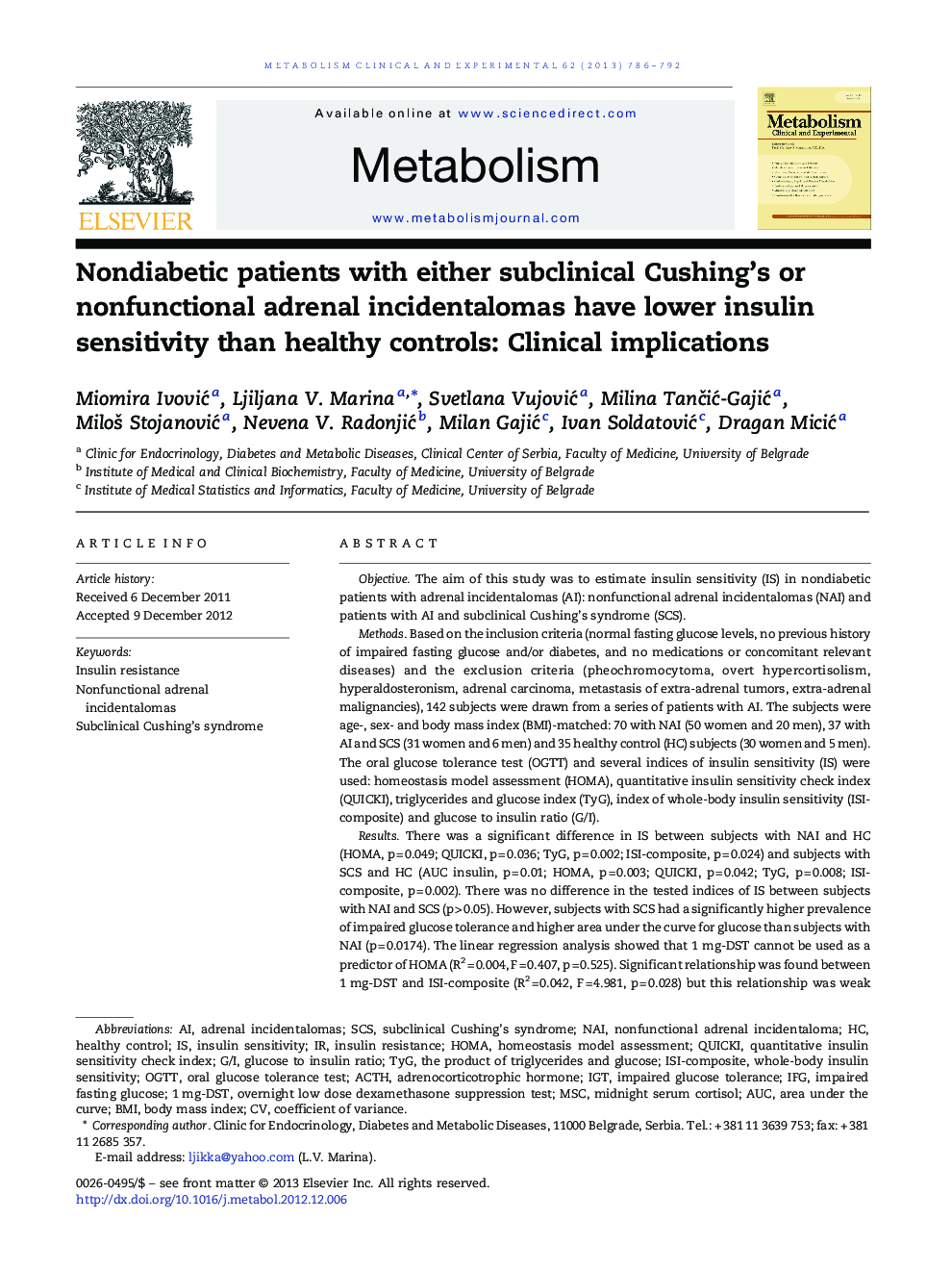| کد مقاله | کد نشریه | سال انتشار | مقاله انگلیسی | نسخه تمام متن |
|---|---|---|---|---|
| 2805520 | 1157061 | 2013 | 7 صفحه PDF | دانلود رایگان |

ObjectiveThe aim of this study was to estimate insulin sensitivity (IS) in nondiabetic patients with adrenal incidentalomas (AI): nonfunctional adrenal incidentalomas (NAI) and patients with AI and subclinical Cushing's syndrome (SCS).MethodsBased on the inclusion criteria (normal fasting glucose levels, no previous history of impaired fasting glucose and/or diabetes, and no medications or concomitant relevant diseases) and the exclusion criteria (pheochromocytoma, overt hypercortisolism, hyperaldosteronism, adrenal carcinoma, metastasis of extra-adrenal tumors, extra-adrenal malignancies), 142 subjects were drawn from a series of patients with AI. The subjects were age-, sex- and body mass index (BMI)-matched: 70 with NAI (50 women and 20 men), 37 with AI and SCS (31 women and 6 men) and 35 healthy control (HC) subjects (30 women and 5 men).The oral glucose tolerance test (OGTT) and several indices of insulin sensitivity (IS) were used: homeostasis model assessment (HOMA), quantitative insulin sensitivity check index (QUICKI), triglycerides and glucose index (TyG), index of whole-body insulin sensitivity (ISI-composite) and glucose to insulin ratio (G/I).ResultsThere was a significant difference in IS between subjects with NAI and HC (HOMA, p = 0.049; QUICKI, p = 0.036; TyG, p = 0.002; ISI-composite, p = 0.024) and subjects with SCS and HC (AUC insulin, p = 0.01; HOMA, p = 0.003; QUICKI, p = 0.042; TyG, p = 0.008; ISI-composite, p = 0.002). There was no difference in the tested indices of IS between subjects with NAI and SCS (p > 0.05). However, subjects with SCS had a significantly higher prevalence of impaired glucose tolerance and higher area under the curve for glucose than subjects with NAI (p = 0.0174). The linear regression analysis showed that 1 mg-DST cannot be used as a predictor of HOMA (R2 = 0.004, F = 0.407, p = 0.525). Significant relationship was found between 1 mg-DST and ISI-composite (R2 = 0.042, F = 4.981, p = 0.028) but this relationship was weak and standard error of estimate was high. The linear regression model also showed that ACTH cannot be used as a predictor of HOMA (R2 = 0.001, F = 0.005, p = 0.943) or ISI-composite (R2 = 0.015, F = 1.819, p = 0.187).ConclusionsInsulin resistance is a major cardiovascular risk factor; therefore, the assessment of IS in patients with AI, even nonfunctional, has a valuable place in the endocrine workup of these patients.
Journal: Metabolism - Volume 62, Issue 6, June 2013, Pages 786–792